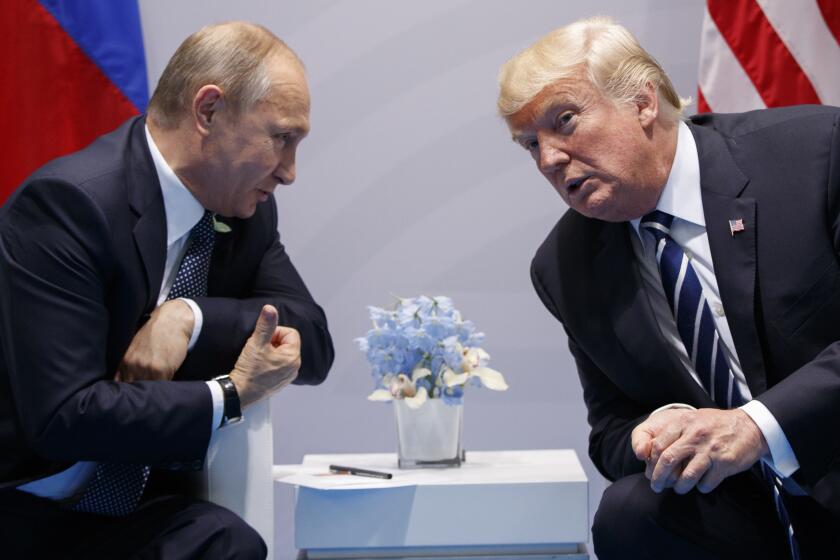Fashion 88 : Dallas Rounds Up Soviet-Made Designs
- Share via
It was supposed to be the season Moscow stormed Manhattan: Viyacheslav (Slava) Zaitsev, the favorite Soviet designer of Raisa Gorbachev, wife of Soviet leader Mikail Gorbachev, took his massive couture collection to New York last fall and dropped it on the U.S. fashion industry.
But it turned out to be a bummer. Not one item in Zaitsev’s show was purchased by one American store buyer.
Make a Comeback
Since then, the designer has been gearing up to make a comeback. And maybe he will, but not as soon as he expected. At the last moment, Zaitsev’s latest designs have been pulled from a show scheduled to coincide with April’s designer collections in New York.
His latest styles reportedly suffer from the same problems that marred his earlier collection.
“The first garments were so costume-y and detailed that it’s questionable whether they could be manufactured in this country at all, or marketed,” says Jimmy Tanner of the Tanner manufacturing company in North Carolina. Tanner turned down an offer to produce last fall’s clothes.
Despite disappointments about the Soviet superstar’s work, the U.S. fashion industry hasn’t seen the last of garments born of glasnost --a Soviet buzzword for social and political openness.
Exchange Program
This week in Dallas, members of the apparel business are still talking about the success of a March 18 show of Soviet fashion designers’ latest works. It was held at the Dallas Apparel Mart as part of a quietly continuing exchange program called Design for Peace.
The project got under way last September when 10 American designers and students, including three from the Otis Art Institute of the Parsons School of Design in Los Angeles, and 10 Soviet designers co-produced a collection in Moscow. It was a first attempt to create a line that would appeal both to Soviet and American consumers. The results were displayed in Moscow only, and never manufactured. The Texas show featured all Soviet designers--Alexander Igmand, Alexi Koreshkov and Irina Krutikova were the biggest names. Their moderately priced clothes are already worn by Soviet citizens, most of them people in the arts, according to Tanya Roslaztseva, a spokeswoman for the design group.
“In Dallas, we showed the Soviet way of dress,” she says. “We have our own style. We have some traditions in the area of clothes, and we’d like to communicate them to others. If it is interesting to the American public, we shall be glad to work with America.”
The show featured weekend wear, more sophisticated dresses and suits, including a knitwear group, some lavish furs and a menswear collection. Of the furs, a group of dyed squirrel coats ranged in colors from smoky gray and olive green to orange and turquoise.
The women’s suits, with skirts from mini to just-above-the-knee lengths, curved in at the waist and had soft shoulders like recent shapes from Paris. Sweater-knit dresses fit close to the body.
Men’s suits seemed to be more English than Italian inspired, with double-breasted jackets and wide, pleated pants in conservative wool tweeds. Many were topped by matching reefer coats with velvet collars.
Cossack Styles
Almost every outfit for men as well as women secured its Russian roots by way of a classic Russian hat--Cossack stovepipe styles, fitted hoods, berets and pillboxes all with a “Dr. Zhivago” flair.
“The show was proof there’s more to Russian fashion than Slava Zaitsev,” says Michael Owen, who is very active in promoting the U.S.-Russian Design for Peace project. Some of the clothes shown in Texas are low priced enough to sell directly to U.S. stores as import fashions, he believes. But during this introductory exhibition of the Soviet designs, none of the manufacturers or store buyers in the audience had the option to do anything but look.
“First, we wanted to see if there was an interest,” Owen says. He adds that several manufacturers did express interest in talking business, but none made a commitment. Next on Owen’s aggressive business agenda for the project is another convening of the U.S.-Russian design team, this time at Texas Woman’s University in Denton, Tex., in May. And in November, he will help coordinate a U.S. fashion design week in Moscow.
Given his plan “to get American merchandise flowing in the Soviet market and vice versa,” Owen seems doubly determined to get past the Zaitsev fiasco.
“After all the publicity about Slava, he may not be the first one to make inroads into America’s fashion market,” Owen notes. “We don’t want his success or failure to influence the success of all Soviet fashion.”
More to Read
Sign up for Essential California
The most important California stories and recommendations in your inbox every morning.
You may occasionally receive promotional content from the Los Angeles Times.










